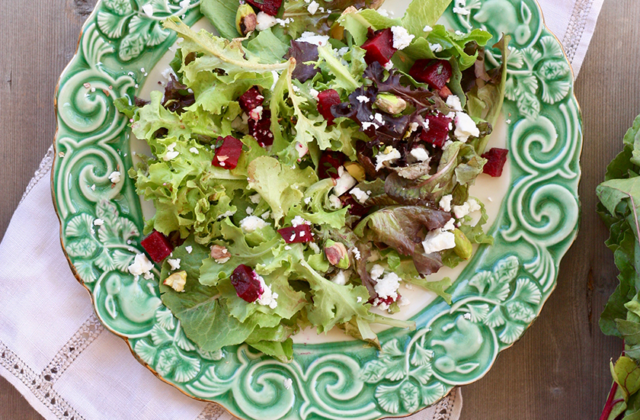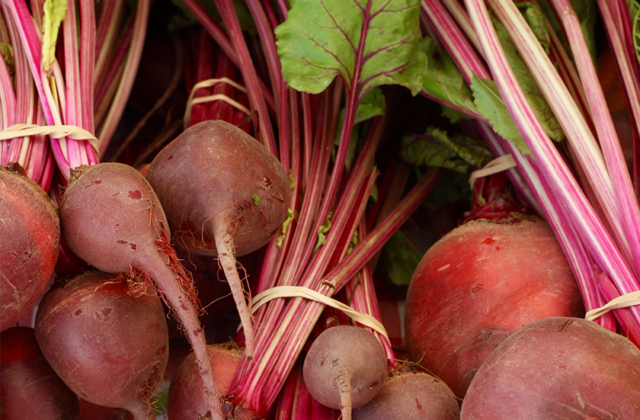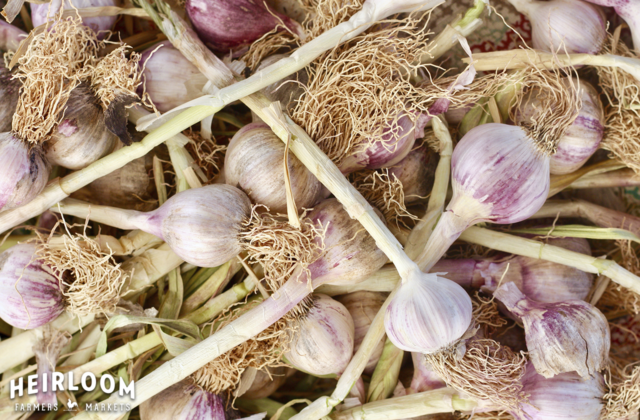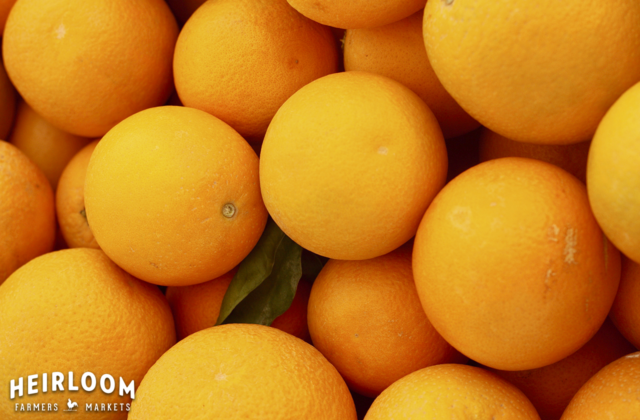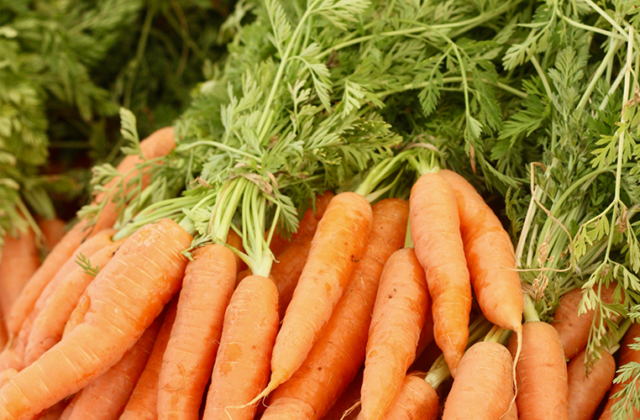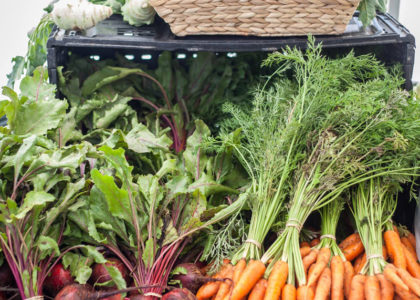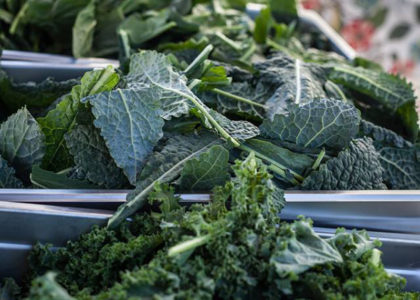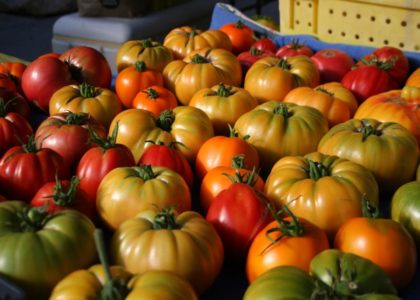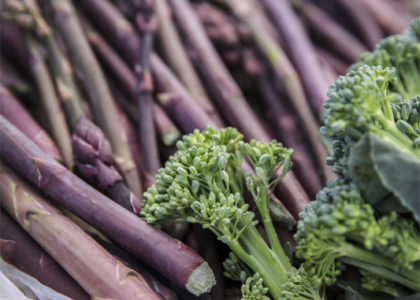Farm To Table Report – May/June 2018
Heating UP
Spring’s shift from warm to hot is noticeable at the farmers market in May, when the last of the local citrus is accompanied by heaps of tender summer squash, juicy ripe tomatoes, and cured garlic so pretty you could hang it on your wall. Along with a highly anticipated harvest, May brings with it harsh temperatures that require local farmers to take extra precaution in the fields. Just as Heirloom Farmers Markets adjusts their hours from 8 a.m. to 12 p.m. to accommodate shoppers and vendors this time of the year, farmers must change their working and watering schedules to protect themselves and their plants. With a lot of planning and hard work, farmers across southern Arizona are able to provide us with locally grown fruits and vegetables throughout the entire summer.
Sauntering through the farmers market stalls in May, you might notice that, unlike every supermarket’s identical produce section, not every farmer offers the same selection. In fact, it may seem as if some farmers aren’t growing produce from the same season. This is because of the varying elevations and microclimates in the cities across southern Arizona where our farmers grow. Farmers who sell their produce at Heirloom Farmers Markets cultivate land across the region, in Tucson, Willcox, Marana, Cascabel, and even the banks of Aravaipa Creek. It’s far too warm to grow greens, beets, and carrots in Tucson right now, but farmers who grow in cooler areas of the region will extend our access to these cool-weather crops for a few more weeks.
Thanks to the relatively cooler weather at Sleeping Frog Farms, located in Cascabel near the San Pedro River, owner Clay Smith and his fellow farmers can continue to grow cool-weather crops outdoors through the month of May. While they spend the month of May transitioning from cool to warm-weather crops, Sleeping Frog Farms will offer carrots, beets, Swiss chard, green onions, spinach, collards, and citrus at the market. Keep an eye out for their outstanding peaches, grown in an orchard on Mount Graham, near the end of the month for a juicy taste of summer. For Smith, the biggest challenge of growing in the summer months is heat stress on plants and people. Managing the heat necessitates heavy field work in the wee hours of the morning and the late hours of the night, as well as an entire day of processing in between.
Joe Marlow of Southwinds Farm, located in the San Pedro Valley, will utilize the valley’s cooler temperatures to continue growing spring crops like asparagus, carrots, beets, peas, and fennel in May. Just last week, Marlow and his team harvested 400 pounds of the season’s last salad turnips. Stock up on their sweet salad turnips and crunchy orange carrots for a reminder of spring on the hot days to come. Looking ahead, Marlow and his team are preparing for rising temperatures by watering their plants deeply and installing new shade cloth on the farm, as well as planting warm weather crops, like Suyo long cucumbers, seed potatoes, and their ever-popular salad greens mix.
The best way to get a taste of everything that Southwinds Farm is growing this summer is to sign up for their 16-week CSA program, which guarantees you a great variety of their produce every week. CSA, or community supported agriculture, programs give small farms like Southwinds access to a lump-sum of cash that they can use for costly projects, like wind tunnels, backup generators, and seed purchases. Although CSA shareholders pay the full price of their share up front, each comes out to just $15––a phenomenal deal for an array of sustainably grown local produce.
Here in Tucson, the tomato-growing family known at the market as “Family Tomatoes” is growing a variety of greenhouse tomatoes in the heart of the city. By the time their tomato plants stop producing in about two months, our farmers who grow in cooler areas of southern Arizona will have ripe tomatoes to bring to the market. Growing tomatoes in Tucson’s warm climate enables Family Tomatoes to help fill the tomato gap and ensure that we have sweet, juicy tomatoes all summer long.
Maria and Miguel Quijada prepare for summer at Wild Child Gardens in Marana by adjusting their watering schedule, applying lots of mulch, planting shade-bearing plants (like sunflowers and okra) to protect less-heat-loving plants, and growing heirloom varieties that are not only heat-tolerant, but wonderfully flavorful.
Heirloom plants come from seeds that have been passed down for generations; because heirloom plants are open-pollinated, farmers can save their seeds every year and help to preserve plant diversity. Local farmers often grow heirloom plants because they can choose varieties based on how they taste, what they’re good for, and how well they grow in hot, dry places like the Southwest. (Unlike industrial farms, small local farms can prioritize taste and quality over growing massive yields of produce.) Heirloom plants don’t produce as much or as quickly as hybrids do, but they make up for it with phenomenal taste, texture, and beauty. While supermarkets only carry a small selection of heirloom produce (namely tomatoes), farmers’ market stalls are teeming with beautiful heirloom tomatoes, squash, beans, melons, and more.
Instead of using hybrids, Maria Quijada chooses “heirlooms that are local or from other hot locations like India, Thailand, Jamaica,” she says. In May, Wild Child Gardens will be selling their soil-grown heirloom tomatoes, cucumbers, peppers (including alluring purple jalapeños), rat tails (heirloom radish pods that, according to Quijada, are “long, skinny, dip-able … crunchy, juicy, and spicy”) and planting more heirloom plants like purple Myanmar and Molokai sweet potatoes, malabar spinach, and orach to sell in the weeks to come.
Cochise Family Farm grows a plethora of purple heirloom produce to sell at the market. Their purple passion asparagus––dark purple in color and sweet as snap peas––never lasts long, but is a wonderful springtime treat if you can get your hands on a bundle. If the asparagus are gone too soon, try their deep purple scarlet kale and ruby lettuce for a pop of purple in your salads. While you’re at it, grab some freshly harvested purple Italian garlic from In the Beginning Farm and keep it to use for future soups, sauces, and salad dressings. Choosing heirloom produce over conventional store-bought produce will brighten your plate, introduce you to wonderful new flavors, and help support local farmers and plant diversity.
Have plans for mother’s day?
Read our Mother’s Day at the Market blog for fun date ideas with your mom!
